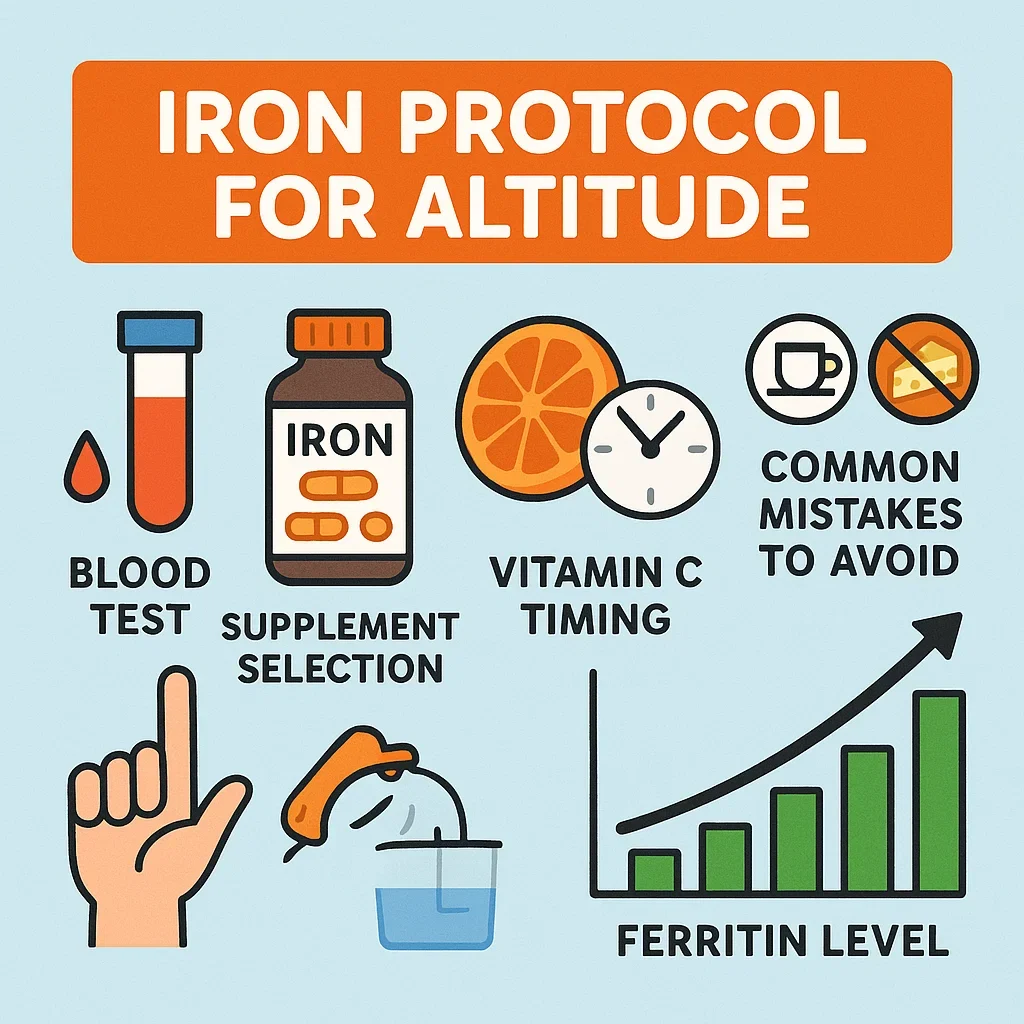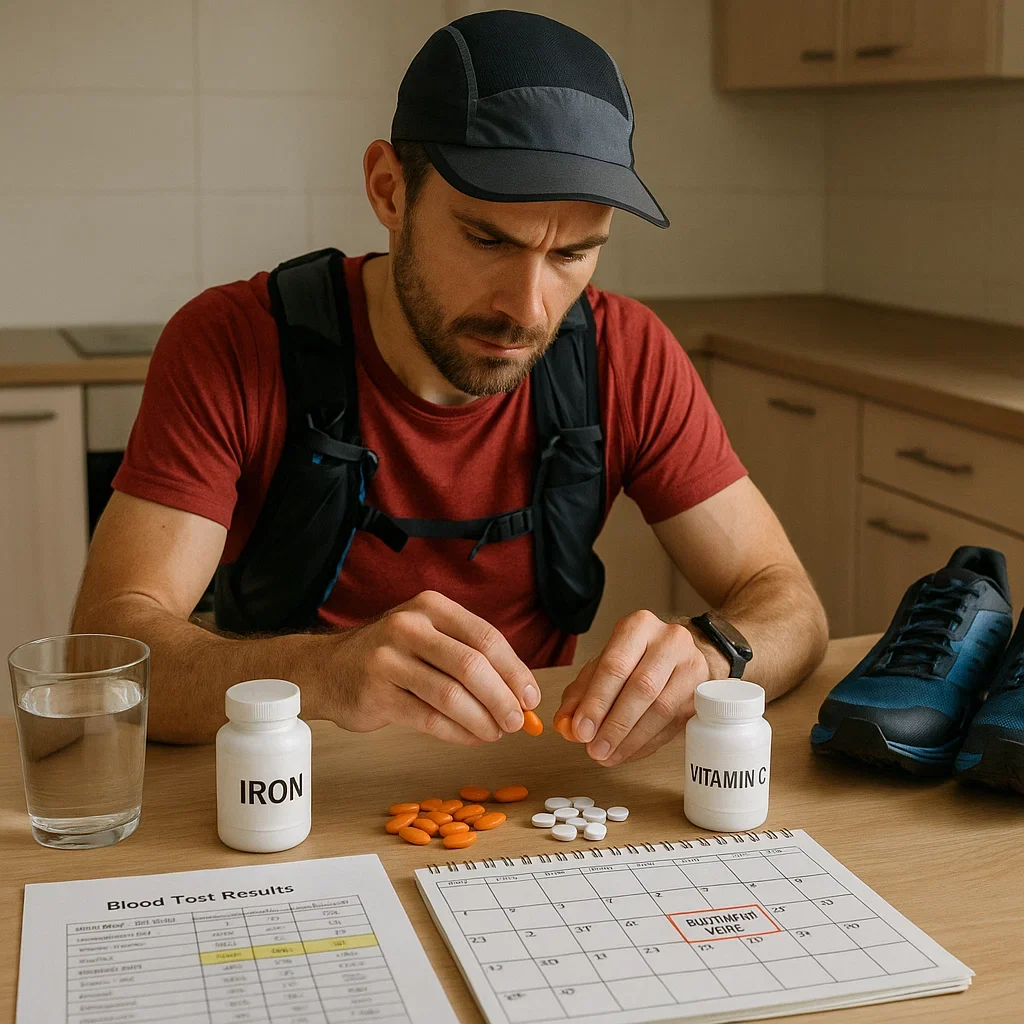Best Iron Protocol for High-Altitude Running: Ferritin, Timing & Supplementation for Ultrarunners
Want to conquer mountain ultras without getting crushed by fatigue? Your secret weapon isn’t fancy gear—it’s iron.
Mastering iron protocols—especially your ferritin and supplementation strategy—can mean the difference between thriving at altitude and hitting the dreaded wall. This Lost Pace guide gives you the science, best timing, and common mistakes to avoid so your next high-altitude race becomes your strongest yet.
🩸 Why Iron Matters at Altitude
- Oxygen Delivery: Iron is essential for making hemoglobin, the protein in red blood cells that transports oxygen.
- Altitude Stress: At high altitudes, your body produces more EPO (erythropoietin) to stimulate red blood cell creation—but this only works if you have enough stored iron.
- Performance: Low iron = low hemoglobin = less oxygen to muscles = slower pace, earlier fatigue, higher risk of AMS.
- Endurance Adaptation: Every altitude study (and top coach) agrees: “Fix iron first or adaptation fails.”
🔬 Ferritin: Your Secret Weapon for Altitude Ultras
- What is Ferritin? Ferritin is your body’s iron storage protein—a snapshot of available iron for new red blood cells.
- How to measure: Ask your doctor for a “serum ferritin” test, ideally 6–10 weeks before your altitude block or race.
- Target level: Most coaches recommend 40–100 ng/mL for men and women; closer to 70+ ng/mL for elite mountain events or altitude tent blocks.
- Other key values: Also check hemoglobin, transferrin saturation, and (if possible) C-reactive protein (CRP) to rule out inflammation masking iron status.
📅 Best Iron Protocols & Timing for High-Altitude Runners
- Test Early: Get bloodwork 8–10 weeks before your altitude phase. If ferritin is low, you’ll need 4–8 weeks to build stores.
- Supplement Smart: Take 60–120 mg elemental iron (not just “iron” but elemental iron) per day if ferritin is <50 ng/mL. Use ferrous sulfate, gluconate, or bisglycinate (check labels!).
- Vitamin C Boost: Take iron with 250–500 mg vitamin C and on an empty stomach (or before bed) for best absorption.
- Avoid blockers: No coffee, tea, dairy, or fiber within 1–2 hours of your iron dose—these dramatically reduce uptake.
- Maintenance: Once ferritin is optimal (>50 ng/mL), many runners cut back to 1–3 doses per week or switch to food-first iron sources.
- Race phase: Continue iron during tent/treadmill altitude blocks, but reduce to every other day if gut issues arise.
- Retest: Check blood again 1–2 weeks before departure. If ferritin is still low, adjust plans—don’t risk it.
🚩 Common Mistakes in Iron Supplementation
- Guessing, not testing: Only a blood test can reveal true status—don’t supplement blindly.
- Taking with blockers: Coffee, dairy, or whole grains within an hour reduce iron absorption up to 60%.
- Too much, too late: Starting supplementation the week before altitude is usually too late for real adaptation.
- Ignoring gut symptoms: Constipation or nausea are common—adjust dose or formulation before race week.
- Forgetting to retest: Adaptation is only possible if iron remains optimal—recheck if feeling unexpectedly fatigued.
- Not individualizing: Women, vegetarians, and masters athletes often need higher vigilance due to increased iron loss or lower dietary intake.
❓ Frequently Asked Questions (FAQ)
How soon before my race should I start checking ferritin?
What is “elemental iron”?
Can I get enough iron from food?
What about IV iron or injections?
Should men and women have different protocols?
How do I know if iron is “working”?
Is iron supplementation dangerous?
Do altitude tents or hypoxic workouts affect iron needs?
Can vitamin C from food (like orange juice) replace a supplement?
What should I do if I feel GI upset with iron?
🏁 Summary & Lost Pace Final Thoughts
Altitude ultras are tough—but iron mastery gives you a true edge.
Get your ferritin tested, build up stores in advance, supplement smartly, and retest before you climb. No hacks, no hype: just science and patience. Your muscles, brain, and red blood cells will thank you—on race day and beyond.


About the Author
Lost Pace is an ultramarathon runner, shoe-tester and the founder of umit.net. Based year-round in Türkiye’s rugged Kaçkar Mountains, he has logged 10,000 + km of technical trail running and completed multiple 50 K–100 K ultras.
Blending mountain grit with data, Lost analyses power (CP 300 W), HRV and nutrition to craft evidence-backed training plans. He has co-written 260 + long-form guides on footwear science, recovery and endurance nutrition, and is a regular beta-tester of AI-driven coaching tools.
When he isn’t chasing PRs or testing midsoles, you’ll find him sharing peer-reviewed research in plain English to help runners train smarter, stay healthier and finish stronger.
Ultrarunner · Data geek · Vegan athlete

